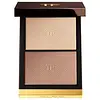What's inside
What's inside
 Key Ingredients
Key Ingredients

 Benefits
Benefits

No benefits
 Concerns
Concerns

 Ingredients Side-by-side
Ingredients Side-by-side

Talc
AbrasiveDimethicone
EmollientIsododecane
EmollientCaprylic/Capric Triglyceride
MaskingSynthetic Fluorphlogopite
Mica
Cosmetic ColorantPhenoxyethanol
PreservativeCI 77163
Cosmetic ColorantCI 77891
Cosmetic ColorantIron Oxides
CI 75470
Cosmetic ColorantCI 19140
Cosmetic ColorantCI 77742
Cosmetic ColorantBis-Dimethicone
EmollientDiisostearyl Malate
EmollientPolyethylene
AbrasiveCetyl Dimethicone
EmollientTin Oxide
AbrasiveAluminum Calcium Sodium Silicate
Calcium Sodium Borosilicate
Calcium Aluminum Borosilicate
Silica
AbrasiveTalc, Dimethicone, Isododecane, Caprylic/Capric Triglyceride, Synthetic Fluorphlogopite, Mica, Phenoxyethanol, CI 77163, CI 77891, Iron Oxides, CI 75470, CI 19140, CI 77742, Bis-Dimethicone, Diisostearyl Malate, Polyethylene, Cetyl Dimethicone, Tin Oxide, Aluminum Calcium Sodium Silicate, Calcium Sodium Borosilicate, Calcium Aluminum Borosilicate, Silica
Linalool
PerfumingBHT
AntioxidantCI 77891
Cosmetic ColorantCI 77491
Cosmetic ColorantCI 77492
Cosmetic ColorantCI 77499
Cosmetic ColorantCI 15850
Cosmetic ColorantCI 42090
Cosmetic ColorantCI 77163
Cosmetic ColorantCI 17200
Cosmetic ColorantCI 77400
Cosmetic ColorantCI 45370
Cosmetic ColorantCI 45410
Cosmetic ColorantCI 15985
Cosmetic ColorantCI 19140
Cosmetic ColorantCI 77742
Cosmetic ColorantCI 45380
Cosmetic ColorantCI 73360
Cosmetic ColorantCI 75470
Cosmetic Colorant
 Reviews
Reviews

Ingredients Explained
These ingredients are found in both products.
Ingredients higher up in an ingredient list are typically present in a larger amount.
CI 19140 is also known as Tartrazine. Tartrazine is a synthetic dye used in cosmetics, foods, and medicine to add a yellow color.
Tartrazine is created from petroleum and is water-soluble.
Some people may experience allergies from this dye, especially asthmatics and those with an aspirin intolerance.
Learn more about CI 19140Ci 75470 is a bright-red pigment. It is AKA carmine.
Carmine is derived from insects such as the cochineal beetle. This ingredient has been used as a natural dye for over 2000 years.
This synthetic powder is used to add a pearly/white color in cosmetics.
This ingredient is used to add a violet color to cosmetics.
It is created by reacting phosphoric acid, ammonium dihydrogen orthophosphate, and manganese dioxide.
Ci 77891 is a white pigment from Titanium dioxide. It is naturally found in minerals such as rutile and ilmenite.
It's main function is to add a white color to cosmetics. It can also be mixed with other colors to create different shades.
Ci 77891 is commonly found in sunscreens due to its ability to block UV rays.
Learn more about CI 77891